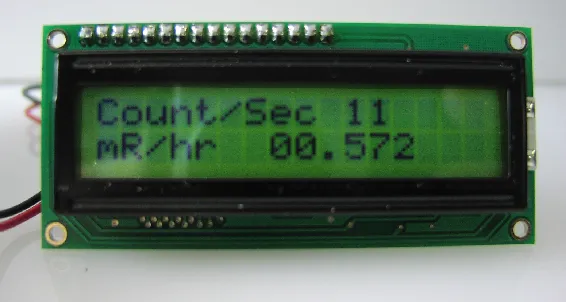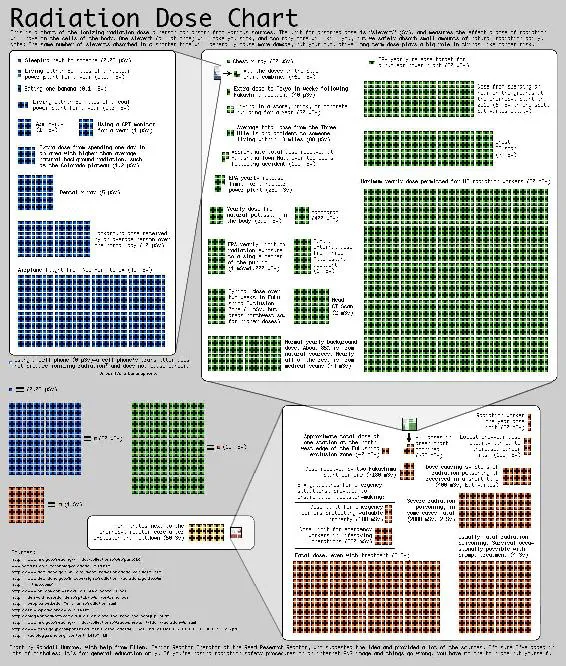![]()
1 - What is Radiation?
Figure 1.1
Ionizing Radiation
Before we use our Geiger counter to detect and measure radiation, we ought to define what we mean by radiation.
Electromagnetic radiation includes long radio waves to ultra-short gamma rays. In this broad view, radiation can include the heat given off from a candle, light emitted by an LED, or from particles emitted by uranium ore. To narrow our definition of radiation for the purposes here, we are confining it to what is considered ionizing radiation. Ionizing radiation is radiation that can strip electrons from atoms or molecules, thereby making the resulting atom or molecule an ion.
The types of ionizing radiation that we will be measuring and performing experiments with are gamma rays, x-rays, and beta and alpha particles.
Alpha particles are massive particles consisting of two neutrons and two protons. They are equivalent to the nucleus of a helium atom. Alpha particles have a net positive charge. This radiation has a low penetration power. A few inches of air or a piece of paper can effectively block alpha particles. The outer skin of our body protects us from alpha particles.
Surprisingly, if an alpha particle emitter is ingested or inhaled, the alpha radiation is dangerous. (See “Q” factor) Because alpha particles are massive, they have a lot of kinetic energy. When it strikes inside our body, it can damage DNA, break chemical bonds, and create tissue damage. So, while its penetration is low, the local damage, if ingested, is considerable.
Beta particles are electrons, identical to the electrons found in atoms. Beta particles have a net negative charge. They have low penetrating power. Most beta radiation can be blocked by 1/8” (4mm) of aluminum.
Gamma and X-rays are high energy ultrashort electromagnetic radiation. This classification of radiation has the greatest penetrating power. High energy gamma radiation is able to pass through several centimeters of lead and still be detected on the other side. Gamma radiation is attenuated by dense materials such as lead. Gamma radiation is produced naturally from the decay of some radioactive materials. X-rays, on the other hand, is man-made radiation used in medicine and dentistry. X-rays’ penetrating power is used to take internal x-ray photographs of the human body and teeth. While X-rays are manmade electromagnetic radiation, their frequency is so high that the radiation is ionizing.
Detecting Radioactivity
There are many instruments available for detecting and measuring radioactivity. We are focused on using the Geiger counter for our detection and experiments.
Geiger counters are instruments that can detect and measure radioactivity using a Geiger Mueller tube. Geiger Mueller tubes are commonly referred to as a GM tube. The original design of the GM tube, created by Hans Geiger and E.W. Mueller in 1928, hasn't changed much, and the tube's sensor function remains the same.
Figure 1.2
Radiation, as it passes through the GM tube, ionizes the gas within the tube. The ionization initiates a momentary avalanche of electrons accelerated by the high voltage potential used to power the GM tube. This avalanche creates a momentary conductive path between the wire at the center of the tube (Anode) and the wall of the tube (Cathode), see figure 1 resulting in a 'click' sound. By measuring the number of the clicks, the instrument indicates the radiation levels.
The GM tube sensor is the heart of the Geiger counter, and to be a Geiger counter, the device has to contain a Geiger Mueller (GM) tube. The GM Tube can detect gamma and X-ray radiation, beta particles, and if manufactured with a thin mica window, alpha particles as well.
Measurement of Radiation
Radiation Penetration Calculator
Images SI, Inc. offers a radiation penetration calculator on their website. It can be found at: https://www.imagesco.com/geiger/cal/
There are a few scales that one can use to measure radiation. Depending on your application, one scale may be better than the others.
Radiation Measurements
Roentgen: Is the measurement of energy produced by Gamma or X-Ray radiation in a cubic centimeter of air. It is abbreviated with the capital "R". One milliroentgen, abbreviated "mR", is one-thousandth of a roentgen. One micro roentgen, abbreviated “uR” is one-millionth of a roentgen.
RAD: Radiation Absorbed Dose. Original measuring unit for expressing the absorption of all types of ionizing radiation (alpha, beta, gamma, neutrons, etc) into any medium. One rad is equivalent to the absorption of 100 ergs of energy per gram of absorbing tissue.
REM: Roentgen Equivalent Man is a measurement that correlates the dose of any radiation to the biological effect of that radiation. Since not all radiation has the same biological effect, the dosage is multiplied by a "quality factor" (Q). For example, a person receiving a dosage of gamma radiation will suffer much less damage than a person receiving the same dosage from alpha particles, by a factor of three. So alpha particles will cause three times more damage than gamma rays. Therefore, alpha radiation has a quality factor of three. Following is the Q factor for a few radiation types.
The difference between the rad and rem is that the rad is a measurement of the radiation absorbed by the material or tissue. The rem is a measurement of the biological effect of that absorbed radiation.
For general purposes, most physicists agree that the Roentgen, Rad, and Rem may be considered equivalent.
System International (SI) of Units
The System International of unit for radiation measurements is now the official system of measurements. This system uses the “gray” (Gy) and “sivert” (Sv) for absorbed dose and equivalent dose respectively.
The conversion from one system to another is simple:
![]()
To get an idea of this visually, try using the Radiation Dose Chart below.
Figure 1.3
Chart in figure 1.3 is public domain. No copyright is implied. Anyone is free to use this chart anywhere with no permission necessary. Please not...






